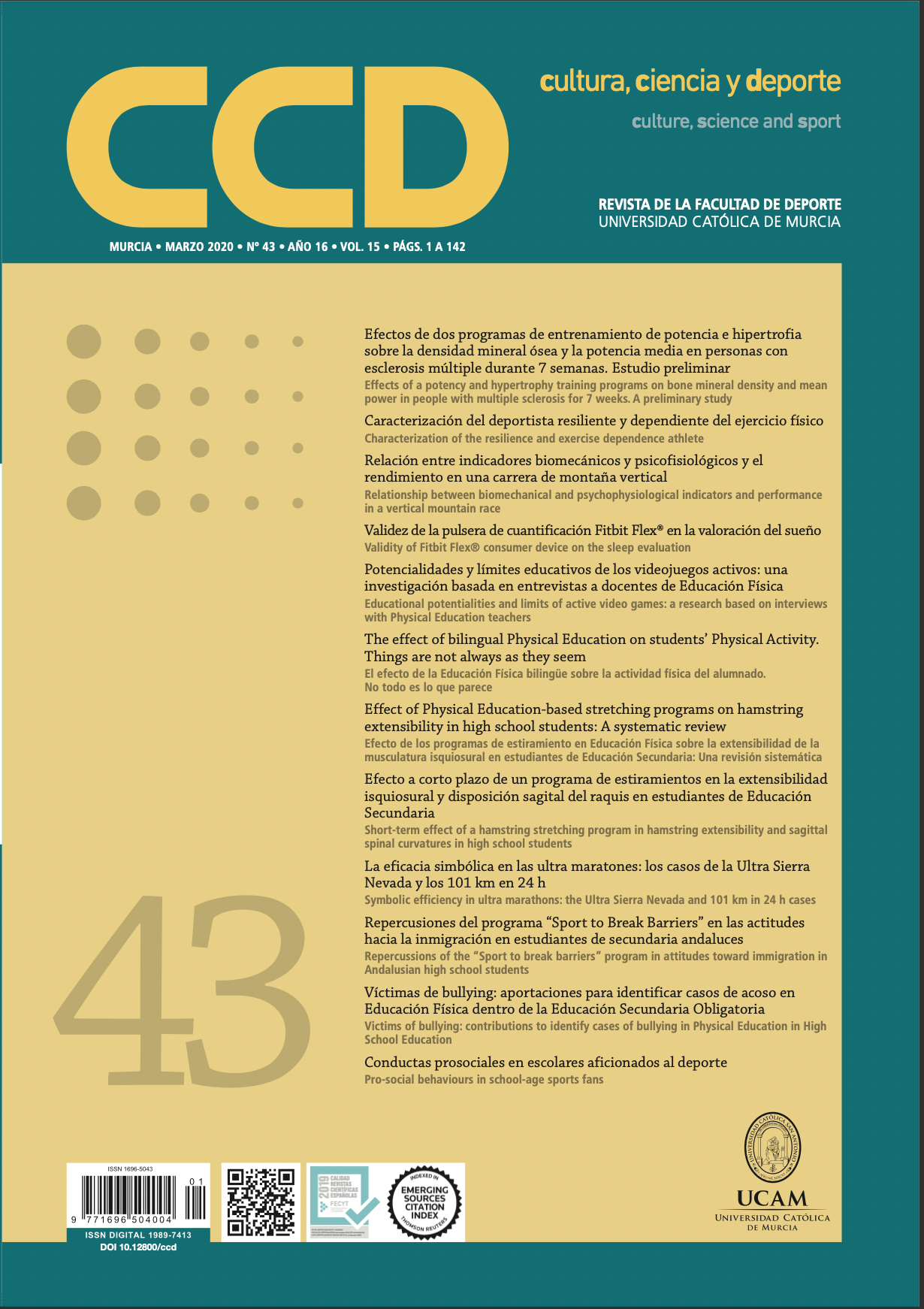Conductas prosociales en escolares aficionados al deporte.(Pro-social behaviours in school-age sports fans).
DOI:
https://doi.org/10.12800/ccd.v15i43.1405Keywords:
niños, comportamiento, socialización, competición.Abstract
Los objetivos de este trabajo de investigación fueron estudiar las conductas prosociales de los seguidores y no seguidores de un deporte, y de los afiliados a una peña y no afiliados, y comparar si las conductas prosociales difieren entre los practicantes de deporte y aquellos que no practican. La muestra se compuso de 1663 niños escolarizados con un rango de edad de 8 a 12 años (M = 9.80; DT = 1.21). Los resultados mostraron mayores niveles de preocupación empática (p < .05; d = .15) en los seguidores al deporte que en los no seguidores. Por otro lado, los seguidores mostraron mayores puntuaciones en la variable autocontrol social (p < .05; d = .12) que los no seguidores. Se concluyó que los seguidores son el grupo que mayor preocupación empática muestra y puntuaciones más altas en autocontrol social en comparación con los jóvenes no seguidores. Por lo tanto, ser seguidor de un deporte puede ser una estrategia para fomentar conductas sociales en los jóvenes escolares.
===
The objectives of this research work were: To study the prosocial behaviours of participants who are sport followers and non-followers and those affiliated in a supporter´s club and non-affiliated; and compare if prosocial behaviours differ between sports practitioners and those who do not practice. The sample consisted of 1663 school children with an age range from 8 to 12 years old (M = 9.80; SD = 1.21). The results showed higher levels of empathic concern (p < .05; d = .15) in sports followers than in non-followers. On the other hand, the followers showed higher scores in the variable social selfcontrol (p < .05; d = .12) than non-followers. It was concluded that the followers are the group with the highest empathic concern and higher scores in social self-control compared to non-followers. Therefore, following sport could be a strategy to improve social behaviours in school children.
References
Allison, P.D. (2002). Quantitative Applications in the Social Sciences: Missing data. Thousand Oaks, California: SAGE Publications, Inc. doi:10.4135/9781412985079
American Psychological Association. (2017). Ethical principles of psychologists and code of conduct (2002, Amended June 1, 2010 and January 1, 2017). Recuperado el 7 de febrero de 2019 de http://www.apa. org/ethics/code/index.aspx
Blasco, M., & Orgilés, M. (2014). Agresividad en menores de 18 años jugadores de fútbol: Diferencias en función del sexo y la edad y en comparación con los jugadores de baloncesto. Cuadernos de Psicología del Deporte, 14(2), 21-26.
Boardley, I., Kavussanu, M., & Ring, C. (2008). Athletes’ Perceptions of Coaching Effectiveness and Athlete-Related Outcomes in Rugby Union: An Investigation Based on the Coaching Efficacy Model. The Sport Psychologist, 22, 269-287.
Brenes-Peralta, C., & Pérez-Sánchez, R. (2015). Empatía y agresión en el uso de videojuegos en niños y niñas. Revista Latinoamericana de Ciencias Sociales, Niñez y Juventud, 13(1), 183-194. doi:10.11600/169271 5x.13110020813
Briggs, S. R., & Cheek, J. M. (1986). The role of factor analysis in the development and evaluation of personality scales. Journal of Personality, 54, 107-148. doi:10.1111/j.1467-6494.1986.tb00391.x
Cantón, E., León, E., & Hernansáiz, B. (2004). Favorecimiento de la Motivación prosocial en la educación primaria a través del deporte. En E. Barberá, L. Mayor, M. Chóliz, E. Cantón, E. Carbonell, C. Candela & C. Gómez (Eds.) Motivos, Emociones y Procesos Representacionales: de la teoría a la práctica (pp. 119-125). Valencia: Fundación Universidad-Empresa-ADEIT.
Cohen, J. (1988). Statistical Power Analysis for the Behavioral Sciences. New York: Academic Press.
Cuenca, V., & Mendoza, B. (2017). Comportamiento prosocial y agresivo en niños: tratamiento conductual dirigido a padres y profesores. Acta de investigación Psicológica, 7(2), 2691-2703. doi:10.1016/j.aipprr.2017.03.005
Dionisio, P., Leal, C., & Moutinho, L. (2008). Fandom affiliation and tribal behaviour: A sports marketing application. Qualitative Market Research an International Journal, 11, 17-39. doi:10.1108/ 13522750810845531
Eisenberg, N., Eggum, N., & Di Giunta, L. (2010). Empathy-Related Responding: Associations with Prosocial Behavior, Aggression, and Intergroup Relations. Social Issues and Policy Review, 4(1), 143-180. doi:10.1111/j.1751-2409.2010.01020.x
Forster, M., Grigsby, T. J., Unger, J. B., & Sussman, S. (2015). Associations between gun violence exposure, game associations, and youth aggression: Implications for prevention and intervention programs. Journal of Criminology, 8. doi:10.1155/2015/963750
Nunnally, J. C. (1978). Psychometric theory. New York: McGraw-Hill.
Ortiz, M. J., Apodaca, P., Etxebarría, I., Fuentes, M. J., & López, F. (2008). Predictores familiares de la internalización moral en la infancia. Psicothema, 20(4), 712-717.
Parise, M., Pagani, A., Cremascoli, V., & Iafrate, R. (2015). Rugby, self-perception and prosocial behaviour: Evidence from the italian “rugby project for schools”. Revista Iberoamericana de Psicología del Ejercicio y el Deporte, 10(1), 57-61.
Pelegrín, A., & Carballo, J. C. (2012). Análisis de las características sociodemográficas de los jóvenes aficionados: principales motivos para participar en el espectáculo deportivo. Anales de Psicología, 28(2), 611- 616. doi:10.6018/analesps.28.2.148791
Pelegrín, A., Garcés de Los Fayos, E. J., & Cantón, E. J. (2010). Estudio de conductas prosociales y antisociales. Información Psicológica, 99, 64-78.
Pelegrín, A., Gómez-Amor, J., Garcés de Los Fayos, E. J., Jara, P., & Martínez-Sánchez, F. (2005). Estudio de las variables agresivas y violentas en deportistas profesionales: Propuesta para el establecimiento de control de estos comportamientos. (Proyecto 06/UPB20/02). Madrid: Centro de Alto Rendimiento y de Investigación en Ciencias del Deporte, Consejo Superior de Deportes.
Pokhrel, P., Sussman, S., Sun, P., Kniazev, V., & Masagutov, R. (2010). Social self-control, sensation-seeking, and substance use in samples of U.S. and Russian adolescents. American Journal of Health Behavior, 34, 374–384. doi:10.5993/AJHB.34.3.12
Samra, B., & Wos, A. (2014). Consumer in Sports: Fan typology analysis. Journal of Intercultural Management, 6(4), 263-288. doi:10.2478/joim2014-0050
Sánchez-Queíja, M. I., Oliva, A., & Parra, A. (2006). Empatía y conducta prosocial durante la adolescencia. Revista de Psicología Social, 21(3), 259-27. doi:10.1174/021347406778538230
Schmitt, N. (1996). Uses and abuses of coefficient alpha. Psychological Assessment, 8, 350-353. doi:10.1037/1040-3590.8.4.350
Silva, F., & Martorell, M. C. (2001). BAS-3, batería de socialización. Madrid: TEA.
Schubert, M., & Seyffert, J. (2017). Fan motives for interacting on social media – the example of the International Table Tennis Federation and Facebook. Current Issues in Sport Science, 2, 1-11. doi:10.15203/ CISS_2017.004
Strayer, J., & Roberts, W. (2004). Empathy and observed anger and aggression in five-year-olds. Social Development, 13(1), 1-13. doi:10.1111/j.1467-9507.2004.00254.x
Sussman, S., McCuller, W. J., & Dent, C. W. (2003). The associations of social self-control, personality disorders, and demographics with drug use among high risk youth. Addictive Behaviors, 28, 1159–1166. doi:10.1016/S0306-4603(02)00222-8
Torregrosa, M. y Cruz, J. (2009). Entusiastas, aficionados y espectadores: sus valores, motivaciones y compromiso. Cultura, Ciencia y Deporte, 12(4), 149-157.
Wei, R. (2007). Effects of playing violent videogames on Chinese adolescents’ pro-violence attitudes, toward others, and aggressive behaviour. Cyberpsychology y Behavior, 10(3), 371-380. doi:10.1089/ cpb.2006.9942
Won, J., & Kitamura, K. (2007). Comparative analysis of sport consumer motivations between South Korea and Japan. Sport Marketing Quarterly, 16, 93-105.
Zukowska, Z., & Zukowski, R. (2008). Promotion of fair play values in sport and education by method of counteracting manifestations of aggression. Promotion of fair play in sport and education. Polish Journal of Sport and Tourism, 15, 149-157
Downloads
Published
How to Cite
Issue
Section
License
The authors who publish in this journal agree with the following terms:
- The authors retain the copyright and guarantee the journal the right to be the first publication of the work as well as licensed under a Creative Commons Attribution License that allows others to share the work with recognition of the authorship of the work and the initial publication in this journal.















